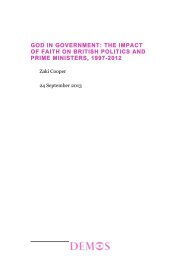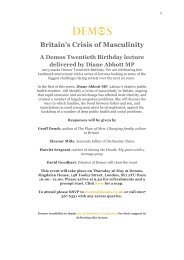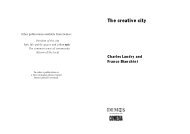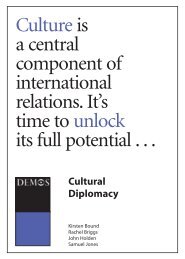Adrian Ellis, Director of AeA Consulting - Demos
Adrian Ellis, Director of AeA Consulting - Demos
Adrian Ellis, Director of AeA Consulting - Demos
Create successful ePaper yourself
Turn your PDF publications into a flip-book with our unique Google optimized e-Paper software.
Department’s Strategic Priorities and Aims.” There is such a hiatus between these asides<br />
and the overwhelming policy preoccupations on the plans themselves but, importantly, it<br />
is a matter <strong>of</strong> degree.<br />
From an historical perspective, the emphasis on the role <strong>of</strong> the arts in “improving<br />
[educational] attainment and behaviour, and encouraging lifelong learning; helping to<br />
combat crime and create safe, active and cohesive communities, [and] …making a very<br />
substantial contribution to the economy” 3 is novel, even perverse. It eschews value-<br />
judgments that imply a hierarchy <strong>of</strong> cultural value; emphases the quantitative in a field<br />
where qualitative assessments have been regarded as central; and aspires to judge cultural<br />
organisations by their efficacy in addressing social and economic agenda that could in<br />
some cases be addressed more effectively directly.<br />
Indeed, the social historian Joli Jensen has recently sought to identify the source <strong>of</strong> the<br />
deep-rooted but – she argues - unfounded belief in the transformational power <strong>of</strong><br />
investment in culture on social ills in the very desire not to have to address social<br />
problems more directly – investment in culture as a form <strong>of</strong> displacement activity.<br />
“Many <strong>of</strong> us yearn to find an easy way to make our cities better, our lives safer, our<br />
children smarter . . .. But this is a dangerous illusion…we must stop imagining that we<br />
can inject children, classrooms, or communities with good culture and make them<br />
better." 4<br />
Four sets <strong>of</strong> partially overlapping arguments have been particularly influential:<br />
• Economic – investment in certain arts has a high ‘multiplier effect’, generating<br />
direct and indirect expenditure, through the first round <strong>of</strong> construction or other<br />
investment related activity and subsequently by attracting inward investment and<br />
© AEA <strong>Consulting</strong> 8






